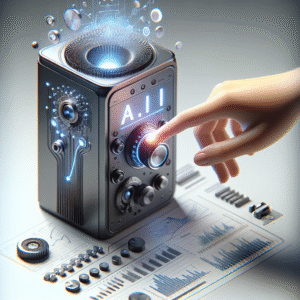Unlocking the Power of Observability: Proven Strategies for AI Application Success
Table of Contents
- Introduction
- What is Observability?
- The Importance of Observability in AI Applications
- Key Components of Observability
- Challenges in Achieving Observability
- Success Stories: Observability in Action
- Best Practices for Implementing Observability
- Tools and Technologies for Observability
- The Future of Observability in AI
- Conclusion
Introduction
In today’s fast-paced world of artificial intelligence (AI), being able to monitor and understand complex systems is absolutely vital. As more businesses turn to AI applications to make informed decisions, enhance customer experiences, and streamline their operations, the idea of observability has become a crucial part of making sure these systems run smoothly. But let’s break it down: what exactly does observability mean, and why should we care about it when it comes to AI applications?
Simply put, observability refers to how well we can figure out a system’s internal states just by looking at its external outputs. Think of it as gaining a clear view of what’s happening inside AI systems. This clarity is essential for troubleshooting, boosting performance, and ensuring that AI models churn out accurate results.
Here’s a staggering fact: a recent Gartner report highlights that more than 80% of organizations that embrace AI don’t meet their intended goals. One major reason for this? A lack of effective observability measures. Without solid insights into how AI applications are performing, organizations risk rolling out models that might not just underperform but could also lead to wrong or biased outcomes.
This blog post aims to give you a thorough understanding of observability in AI applications. We’ll delve into why it’s important, the key components to consider, some of the challenges organizations face, and real-life success stories. By the time you finish reading, you’ll walk away with valuable insights on how to boost the performance and reliability of your AI systems.
What is Observability?
Observability isn’t just a buzzword; it’s a concept borrowed from control theory that’s taken root in software engineering, especially with the surge of microservices and cloud-native architectures. It’s all about the processes and tools we use to monitor and make sense of a system’s inner workings based on its outputs.
Definition and Key Concepts
At its heart, observability revolves around three key pillars: metrics, logs, and traces. Together, they paint a complete picture of how a system is doing.
- Metrics: These are the numbers that tell us how we’re performing—think response times, error rates, and resource usage.
- Logs: These are the detailed records of events and transactions that help us grasp what’s going on inside the system.
- Traces: This is essentially a map of the journey a request takes through the system—perfect for visualizing complex interactions and spotting bottlenecks.
How Observability Differs from Monitoring
Now, you might hear people use “observability” and “monitoring” interchangeably, but they’re not quite the same. Monitoring is all about gathering and analyzing data to keep tabs on system health, usually through pre-set thresholds and alerts. On the flip side, observability focuses on comprehending the system’s behavior and using data to troubleshoot and fine-tune performance.
The Importance of Observability in AI Applications
The importance of observability in AI applications is huge. These systems are complex beasts, often involving a web of interconnected components, algorithms, and data sources. This complexity can make it tricky to pinpoint and fix issues when they arise.
Ensuring Model Performance and Accuracy
AI models learn from past data, but they can run into situations they’ve never seen before. This is where observability comes in handy, allowing organizations to keep a close eye on model performance in real-time. By monitoring for drift, bias, and other signs of degradation, organizations can swiftly make adjustments to ensure better outcomes.
Enhancing User Trust and Transparency
In today’s world, where transparency and accountability are everything, observability is key to building user trust in AI applications. By shedding light on how decisions are made, organizations can cultivate reliability and confidence among their users.
Key Components of Observability
To really nail observability in AI applications, organizations need to pay attention to several crucial components that work hand-in-hand to offer deep insights.
Data Collection and Integration
The first step in achieving observability is gathering relevant data from a variety of sources—this could be infrastructure, application logs, or user interactions. Integrating this data into a centralized observability platform enables organizations to analyze everything cohesively.
Real-time Analytics and Visualization
Once the data is in, organizations need robust analytics tools to process and visualize it in real time. Dashboards and visualizations are invaluable here, helping teams quickly spot anomalies and trends, which means faster troubleshooting and decision-making.
Challenges in Achieving Observability
Even though observability is essential, achieving it in AI applications isn’t without its challenges. Organizations must tackle these obstacles to implement effective observability strategies.
Data Overload
Let’s face it: the amount of data produced by AI systems can be overwhelming. Many organizations struggle to sift through the noise to uncover actionable insights. That’s why having effective data management and filtering strategies in place is so critical.
Complexity of AI Systems
AI systems can be intricate, with a multitude of interdependencies and components. Getting to grips with how these elements interact requires a solid understanding and a strong observability framework.
Success Stories: Observability in Action
Plenty of organizations have effectively put observability practices into play to boost their AI applications. These success stories offer valuable lessons and insights for anyone looking to enhance their own observability strategies.
Case Study: Netflix
Take Netflix, for example. As a leader in streaming services, they heavily rely on AI algorithms for personalized content recommendations. By implementing comprehensive observability practices, they can monitor user interactions and model performance in real-time, ensuring that those recommendations stay relevant and engaging for their audience.
Case Study: Uber
Uber is another great example, using observability to fine-tune its ride-hailing algorithms. By consistently keeping an eye on system performance and user feedback, they can quickly spot issues, improving the accuracy and reliability of their services—which ultimately leads to happier customers.
Best Practices for Implementing Observability
So, how can organizations successfully weave observability into their AI applications? Here are some best practices to guide them toward effective monitoring and insights.
Define Clear Objectives
First things first: before diving into observability tools and practices, organizations need to set clear objectives that align with their business goals. Knowing what insights are essential will steer them in selecting the right metrics, logs, and traces.
Invest in the Right Tools
Picking the right observability tools is crucial. Organizations should evaluate different solutions based on their specific needs, scalability requirements, and how well they integrate with current systems.
Tools and Technologies for Observability
There’s a whole slew of tools and technologies available to help organizations implement observability in AI applications. These tools facilitate data collection, analysis, and visualization, helping teams gain insights into system performance.
Prometheus
Prometheus is an open-source monitoring and alerting toolkit that’s all about reliability and scalability. It’s widely used for collecting and storing time-series data, making it a fantastic choice for monitoring AI applications.
Grafana
Grafana is a powerful analytics and monitoring platform that works well with various data sources, including Prometheus. Thanks to its rich visualization capabilities, teams can create custom dashboards for real-time insights.
The Future of Observability in AI
The outlook for observability in AI applications is bright, with new tech and methodologies paving the way for more advanced monitoring and insights. As AI systems keep evolving, organizations will need to adapt their observability practices to stay ahead of the curve.
Increased Automation
One major trend we can expect is increased automation. Tools that harness machine learning algorithms will be able to identify anomalies and insights with little to no human intervention, streamlining the whole monitoring process.
Integration with DevOps
As organizations continue to embrace DevOps practices, integrating observability into the development lifecycle will become essential. This will empower teams to monitor AI applications from development to deployment, ensuring continuous improvement.
Conclusion
In the end, observability is a cornerstone of successful AI applications, offering the insights needed to guarantee performance, accuracy, and user trust. As organizations navigate the often-complex world of AI, adopting effective observability practices is key to unlocking the full potential of their systems.
By diving into the key components, challenges, and best practices of observability, organizations can set themselves up for success in an increasingly AI-driven landscape. Sure, the journey toward effective observability might have its bumps, but the benefits in terms of boosted performance and reliability make it worth the ride.
If you’re looking to elevate your AI applications, now is the time to invest in observability. By taking proactive steps to monitor and understand your systems, you can ensure your AI models deliver the results you need to thrive in a competitive environment.






